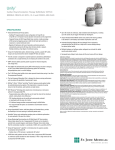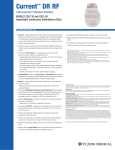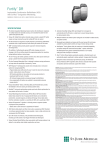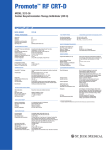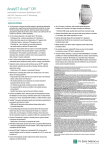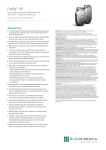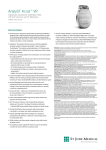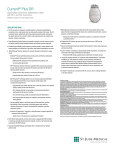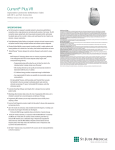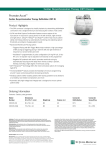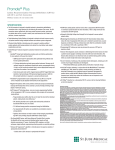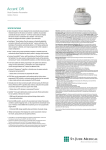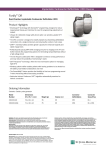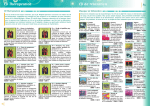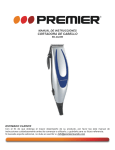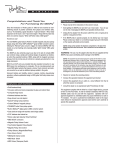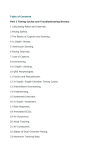Download Fortify™ DR
Transcript
Fortify™ DR Implantable Cardioverter Defibrillator (ICD) MODELS CD2231-40 (DF-1, IS-1) and CD2231-40Q (SJ4) Specifications The Unique 40 J Safety Shock option, delivered energy, provides a greater DFT safety margin and may minimize the need for multiple DFT tests at implant. The SJ4 connector is designed to simplify implants by streamlining defibrillation connections into a single terminal pin and reducing the number of set screws. QHR® chemistry battery provides greater capacity for enhanced longevity and charge times. The addition of antitachycardia pacing (ATP) while charging and prior to charging in the VF zone further extends the programming options for converting tachyarrhythmias before or during charge. The % V-Pacing alert notifies clinics when percent ventricular pacing is greater than the programmed threshold. The Low Frequency Attenuation filter is designed to enhance sensing performance and may reduce the possibility of oversensing T waves. DeFT Response® technology tools provide more clinically proven, noninvasive options for managing high DFTs. –Programmable pulse widths allow the user to tailor the shock to the individual patient, making shocks more efficacious.1 –SVC shocking electrode can be quickly and noninvasively activated or deactivated with the touch of a button. –40 J delivered energy provides unsurpassed energy for defibrillation. –Four programmable tilt options are available to accommodate variances among patients.2 Unique SenseAbility® feature, with Decay Delay and Threshold Start, provides the flexibility to fine-tune sensing to individual patient needs. QuickOpt® timing cycle optimization provides quick and effective optimization for more patients at the touch of a button.3 Unique Morphology Discrimination plus AV Rate Branch SVT discrimination feature helps reduce the risk of inappropriate ICD shocks and is intended to promote fast, accurate diagnosis and delivery of therapy. Clinical data states that this combination resulted in a sensitivity of 100% with a specificity of 85%.4 Unique AF Suppression™ algorithm is clinically proven to suppress episodes of paroxysmal and persistent AF. –Studies show a 25% decrease in symptomatic AF burden.5 AT/AF Alerts notify patients and their clinics when a programmed AT/AF threshold or continuous episode duration has been exceeded, or when a high ventricular rate accompanies the AT/AF episode. Up to 45 minutes of continuous, fully annotated stored electrograms, including up to 60 seconds of pre-trigger information per electrogram. Unique Vibratory Patient Notifier allows even patients with hearing problems to be alerted to a low battery, lead-related complications and more. Automatic Daily High-Voltage (HV) Lead Integrity Test is designed to automatically test the HV lead on a daily basis to ensure therapy delivery for optimal patient safety. Multiple hardware and software system safeguards are included for added security and patient comfort. Decreased device footprint and volume with the most narrow (40 mm) design available for greater patient comfort and range of motion during activity. AutoCapture™ Pacing System offers the maximum in threshold adaptability and patient safety with ventricular Beat-by-Beat™ capture confirmation. The AutoCapture Pacing System automatically delivers a 5.0 V backup safety pulse when noncapture is detected. ACap® Confirm Pacing System periodically completes a threshold search and automatically adjusts amplitude to address patients’ changing atrial thresholds. Designed to reduce unnecessary right ventricular pacing, the Ventricular Intrinsic Preference (VIP®) algorithm allows intrinsic conduction when possible and provides optimized ventricular support when needed. Indications and Usage: The Fortify pulse generators are intended to provide ventricular antitachycardia pacing and ventricular defibrillation for automated treatment of life-threatening ventricular arrhythmias. AF Suppression pacing is indicated for suppression of paroxysmal or persistent atrial fibrillation in patients with the above ICD indication and sinus node dysfunction. Contraindications: Contraindications for use of the pulse generator system include ventricular tachyarrhythmias resulting from transient or correctable factors such as drug toxicity, electrolyte imbalance, or acute myocardial infarction. Warnings and Precautions: Resuscitation Availability. Do not perform device testing unless an external defibrillator and medical personnel skilled in cardiopulmonary resuscitation (CPR) are readily available. Lead System. Do not use another manufacturer’s lead system without demonstrated compatibility as undersensing cardiac activity and failure to deliver necessary therapy may result. Avoiding Shock During Handling. Disable tachyarrhythmia therapy (Enable/Disable Tachy Therapy) or program tachyarrhythmia therapies Off during surgical implant and explant or post-mortem procedures as well as when disconnecting leads as the device can deliver a serious shock if you touch the defibrillation terminals while the device is charged. Additional Pacemaker Implanted. These devices provide bradycardia pacing. If another pacemaker is used, it should have a bipolar pacing reset mode and be programmed for bipolar pacing to minimize the possibility of the output pulses being detected by the device. Modifying the Device. This device has been tested for compliance to FCC regulations. Changes or modifications of any kind not expressly approved by St. Jude Medical could void the user’s authority to operate this device. Suboptimal Radio Frequency (RF) Communication. The Merlin® Patient Care System (PCS) indicates the quality of the RF communication by the telemetry strength indicator LEDs on both the Merlin PCS and the Merlin Antenna. Please see the User’s Manual for a list of potential causes to suboptimal radio communication. Potential Adverse Events: Possible adverse events (in alphabetical order) associated with the system, include, but are not limited to the following: acceleration of arrhythmias (caused by device), air embolism, allergic reaction, bleeding, cardiac tamponade, chronic nerve damage, death, erosion, exacerbation of heart failure, excessive fibrotic tissue growth, extracardiac stimulation (phrenic nerve, diaphragm, chest wall), extrusion, fluid accumulation, formation of hematomas or cysts, inappropriate shocks, infection, keloid formation, lead abrasion and discontinuity, lead migration/dislodgment, myocardial damage, pneumothorax, shunting current or insulating myocardium during defibrillation with internal, or external paddles, potential mortality due to inability to defibrillate or pace, thromboemboli, venous occlusion, venous or cardiac perforation. Patients susceptible to frequent shocks despite antiarrhythmic medical management, may develop psychological intolerance to an ICD or CRT-D system that may include the following: dependency, depression, fear of premature battery depletion, fear of shocking while conscious, fear of losing shock capability, imagined shocking (phantom shock). Refer to the User’s Manual for detailed indications, contraindications, warnings, precautions and potential adverse events. Post-Therapy Pacing (independently programmable from Bradycardia and ATP ) PHYSICAL SPECIFICATIONS Models Telemetry Delivered/Stored Energy (J) Volume (cc) Weight (g) Size (mm) Defibrillation Lead Connections Sense/Pace Lead Connections High-Voltage Can CD2231-40 RF 40/45 35 76 74 x 40 x 14 DF-1 IS-1 Electrically active titanium can PARAMETERS Settings CD2231-40Q RF 40/45 35 75 71 x 40 x 14 SJ4 SJ4, IS-1 Electrically active titanium can Post-Shock Pacing Mode Post-Shock Base Rate (ppm) Post-Shock Pacing Duration (min) Device Testing/Induction Methods DC Fibber™ Pulse Duration (sec) Burst Fibber Cycle Length (ms) Noninvasive Programmed Stimulation (NIPS) Programmable Notifiers (On; Off) Device Parameter Reset Entry into Backup VVI Mode Vibration Duration (sec) Number of Vibrations per Notification Number of Notifications Time Between Notifications (hours) On; Off 15-40 in steps of 5 80-150 ppm Sensing/Detection SenseAbility® Technology Low Frequency Attenuation Threshold Start Decay Delay Ventricular Sense Refractory (ms) Detection Zones SVT Discriminators Reconfirmation Automatic Sensitivity Control adjustment for atrial and ventricular events On; Off (Post-Sensed; Atrial) 50; 62.5; 75; 100%; (Post-Paced; Atrial) 0.2-3.0 mV; (Post-Sensed; Ventricular) 50; 62.5; 75; 100%; (Post-Paced; Ventricular) Auto; 0.2-3.0 mV (Post-Sensed/Post-Paced; Atrial/Ventricular) 0-220 125; 157 VT-1; VT-2; VF AV Rate Branch; Sudden Onset; Interval Stability; Morphology Discrimination (MD) with Manual or Automatic Template Update Continuous sensing during charging ATP Configurations ATP in VF Zone ATP Upper Rate Cutoff Burst Cycle Length Min. Burst Cycle Length (ms) Number of Bursts Number of Stimuli Add Stimuli per Burst ATP Pulse Amplitude (V) ATP Pulse Width (ms) High-Voltage Therapy Ramp; Burst; Scan; 1 or 2 schemes per VT zone ATP While Charging; ATP Prior to Charging; Off 150-300 bpm Adaptive; Readaptive or Fixed 150-400 in increments of 5 1-15 2-20 On; Off 7.5 independently programmable from Bradycardia and Post-Therapy Pacing 1.0 or 1.5 independently programmable from Bradycardia and Post-Therapy Pacing High-Voltage Output Mode Waveform RV Polarity Electrode Configuration Fixed Pulse Width; Fixed Tilt Biphasic; Monophasic Cathode (-); Anode (+) RV to Can; RV to SVC/Can Stored Electrograms Therapy Summary Episodes Summary Lifetime Diagnostics AT/AF Burden Trend Ventricular HV Lead Impedance Trend Histograms PMT Data Real-Time Measurements (RTM) Up to 45 minutes including up to 1 minute programmable pre-trigger data per VT/VF diagnosis/detection electrograms; triggers include diagnosis; therapy; atrial episode; PMT termination; PC shock delivery; noise reversion; magnet reversion; and morphology template verification Diagram of therapies delivered Directory listing of up to 60 episodes with access to more details including stored electrograms History of bradycardia events and device-initiated charging Trend data and counts Multi-Vector Trend Data Event Histogram; AV Interval Histogram; Mode Switch Duration Histogram; Peak Filtered Rate Histogram; Atrial Heart Rate Histogram; Ventricular Heart Rate Histogram; AT/AF Burden; Exercise and Activity Trending; V Rates during AMS Information regarding PMT detections Pacing lead impedances; high-voltage lead impedances; and signal amplitudes 1. Mouchawar G, Kroll M, Val-Mejias JE et al. ICD waveform optimization: a randomized prospective, pair-sampled multicenter study. PACE 2000;23(Part II):1992-1995. 2. Sweeney MO, Natale A, Volosin KJ et al. Prospective randomized comparison of 50%/50% versus 65%/65% tilt biphasic waveform on defibrillation in humans. PACE 2001;24:60-65. 3. Baker JH, Mckenzie J, Beau S et al. Acute evaluation of programmer-guided AV/PV and VV delay optimization comparing an IEGM method and echocardiogram for cardiac resynchronization therapy in heart failure patients and dual-chamber ICD implants. Journal of Cardiovascular Electrophysiology 2007;18:185-191. 4.Sperzel J, Meine M et al. A new automatic update function of the morphology template used for SVT/VT discrimination in an ICD. Europace Supplements 2002;3:A131, #1515. Bradycardia Pacing Permanent Modes DDD(R); DDI(R); VVI(R); AAI(R); Pacer Off Temporary Modes Off; DDD; DDI; VVI; AAI; AAT; DOO; VOO; AOO Rate-Adaptive Sensor On; Off; Passive Programmable Rate and Off; Base Rate (ppm); Rest Rate (ppm); Maximum Tracking Rate (ppm); Delay Parameters Maximum Sensor Rate (ppm); Paced AV Delay (ms); Sensed AV Delay (ms); Rate Responsive AV Delay; Hysteresis Rate (ppm); Rate Hysteresis with Search QuickOpt ® Timing Cycle Optimization Sensed/Paced AV delay Auto Mode Switch (AMS) Off; DDI(R); VVI(R) Atrial Tachycardia Detection Rate 110-300 AMS Base Rate 40; 45; ... 135 Auto PMT Detection/Termination Atrial Pace; Off; Passive Rate Responsive PVARP/VREF Off; Low; Medium; High Ventricular Intrinsic Preference (VIP ®) Off; 50-200 (50-150 in increments of 25; 160-200 in increments of 10) Ventricular AutoCapture™ On; Off Pacing System ACap® Confirm On; Monitor; Off Global Headquarters One St. Jude Medical Drive St. Paul, Minnesota 55117 USA +1 651 756 2000 +1 651 756 3301 Fax Device at ERI; Charge Time Limit Reached; Possible HV Circuit Damage; Atrial Lead Impedance Out of Range; Ventricular Lead Impedance Out of Range; High-Voltage Lead Impedance Out of Range; AT/AF Burden; V Rate During AT/AF; Long AT/AF Episode On On 2; 4; 6; 8; 10; 12; 14; 16 2 1-16 10; 22 Electrograms and Diagnostic Antitachycardia Pacing Therapy Atrial Fibrillation 0.5-5.0 20-100 2-25 stimuli with up to 3 extrastimuli Patient Notifiers AF Management AF Suppression™ Pacing No. of Overdrive Pacing Cycles Maximum AF Suppression Rate Off; AAI; VVI; DDI; DDD 30-100 in increments of 5 Off; 0.5; 1; 2.5; 5; 7.5; or 10 Cardiac Rhythm Management Cardiac Rhythm Management Division 15900 Valley View Court Sylmar, California 91342 USA +1 818 362 6822 +1 818 364 5814 Fax CARDIOVASCULAR St. Jude Medical AB Veddestavägen 19 175 84 Järfälla Sweden +46 8 474 40 00 +46 8 760 95 42 Fax 5.Carlson MD et al. A new pacemaker algorithm for the treatment of atrial fibrillation: results of the Atrial Dynamic Overdrive Pacing Trial (ADOPT). JACC 2003;42:627-633. QHR is a registered trademark of Greatbatch LTD. Neuromodulation U.S. Division 807 Las Cimas Parkway Suite 400 Austin, Texas 78746 USA +1 512 732 7400 +1 512 732 2418 Fax SJMprofessional.com CAUTION: FEDERAL LAW (USA) RESTRICTS THIS DEVICE TO SALE, DISTRIBUTION AND USE BY OR ON THE ORDER OF A PHYSICIAN. Brief Summary: Prior to using these devices, please review the User’s Manual for a complete listing of indications, contraindications, warnings, precautions, potential adverse events and directions for use. Unless otherwise noted, ® or TM indicates a registered or unregistered trademark or service mark owned by, or licensed to, St. Jude Medical, Inc. or one of its subsidiaries. ST. JUDE MEDICAL, the nine-squares symbol and MORE CONTROL. LESS RISK. are registered and unregistered trademarks and service marks of St. Jude Medical, Inc. and its related companies. ©2010 St. Jude Medical, Inc. All rights reserved. Item No.G0317


